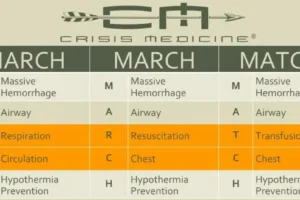
How to accurately estimate burn size to ensure proper patient care
- Posted by Mike Shertz MD/18D
- Categories MARCH
Estimating burn size is not just a technical detail; it’s a critical component of effective burn management.
Researched and written by Mike Shertz, MD/18D, not AI
🕖 Reading Time, 3 minutes
Mis-estimation results in over or under-transfer to burn centers, inappropriate patient treatment, unnecessary healthcare costs, and miscalculations of IV fluid volume needed for burn resuscitation.
Since its introduction in 1951, the “Rule of Nines” has offered a straightforward way to estimate burn sizes, and it continues to be widely used today. However, the Lund-Browder chart introduced in 1942 is seen as more accurate. The most current version breaks the body into 19 regions. The Lund Browder chart was first developed based on body surface calculations fitting 99.9% of the population in 1935.
However, those calculations are questionably no longer accurate because none of the charts take into consideration the current obesity epidemic and resultant increase in body sizes. Although adjusted values are suggested to account for this discrepancy, they are seldom utilized, leading to significant underestimations of burn size for the torso, arms, and legs in obese patients.
Another interesting detail is that the burn charts underestimate the size of anterior torso burns in large-breasted individuals. Bra cup size has been directly correlated to anterior torso surface area.

The “Palmer Method,” presents another approach to estimating burn size, where the palm and palmar surface area of the fingers is correlated to 1% BSA. This is correct in children, but overestimates BSA in adults because an adult male’s palmar surface is 0.8% BSA and female 0.7%. Extrapolated over an entire body, the disparity will add up.
One important reminder: total body surface area burned only includes second or third-degree burns.
- •Superficial burns, described by 19th-century French burn surgeon Boyer as “erythematous (red), but not blistered skin,” are not included in the calculations.
- •Second (partial thickness) burns are “blistered skin leading to superficial ulceration,” and
- •Third degree (full thickness) are “tissue disorganization leading to a dry yellow crust.”
Reference:
For an excellent review of the history of burn charts for burn surface estimation, see:
Burn size estimation: A remarkable history with clinical practice implications
Gretchen J. Carrougher, Tam N. Pham. Burns Open 8 (2024) 47 – 52 https://doi.org/10.1016/j.burnso.2023.12.006
Dr. Mike Shertz is the Owner and Lead Instructor at Crisis Medicine. Dr. Shertz is a dual-boarded Emergency Medicine and EMS physician, having spent over 30 years gaining the experience and insight to create and provide his comprehensive, science-informed, training to better prepare everyday citizens, law enforcement, EMS, and the military to manage casualties and wounded in high-risk environments. Drawing on his prior experience as an Army Special Forces medic (18D), two decades as an armed, embedded tactical medic on a regional SWAT team, and as a Fire Service and EMS medical director.
Using a combination of current and historical events, Dr. Shertz’s lectures include relevant, illustrative photos, as well as hands-on demonstrations to demystify the how, why, when to use each emergency medical procedure you need to become a Force Multiplier for Good.




